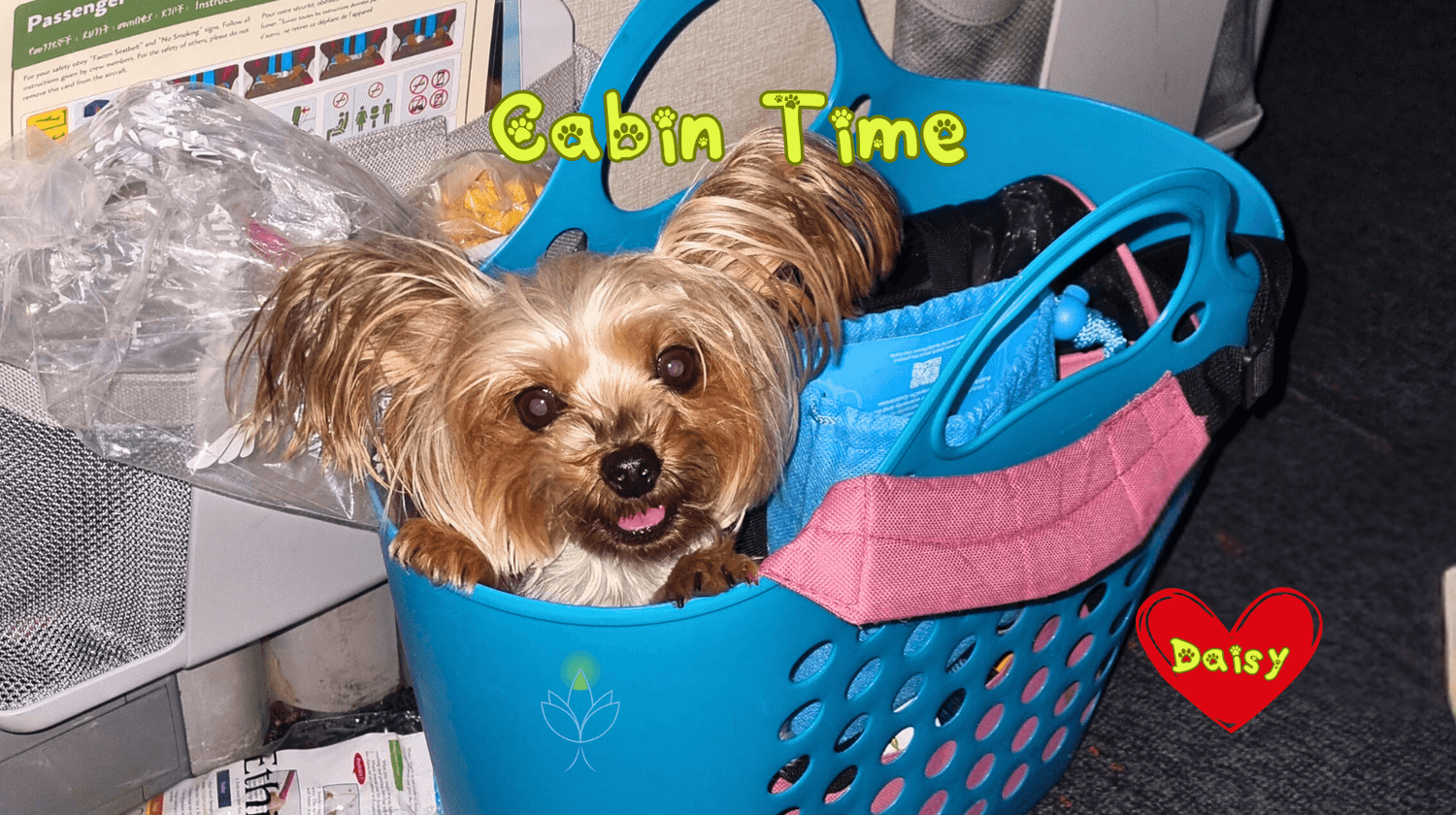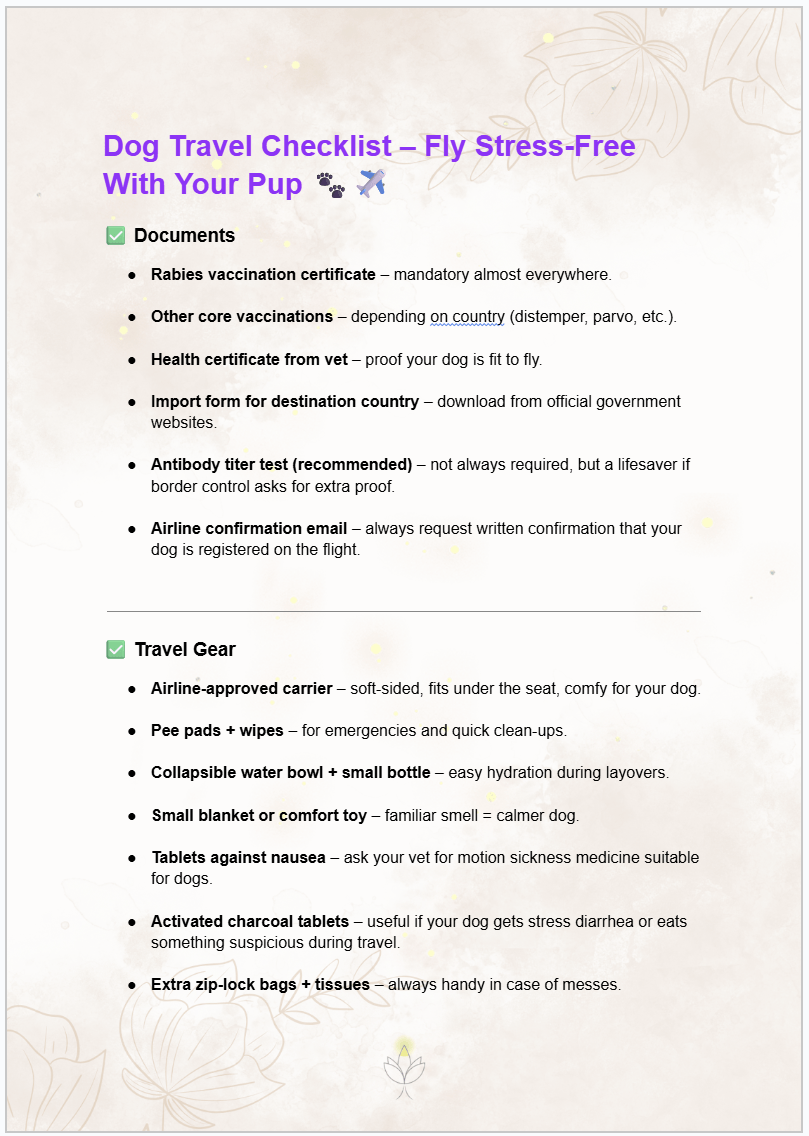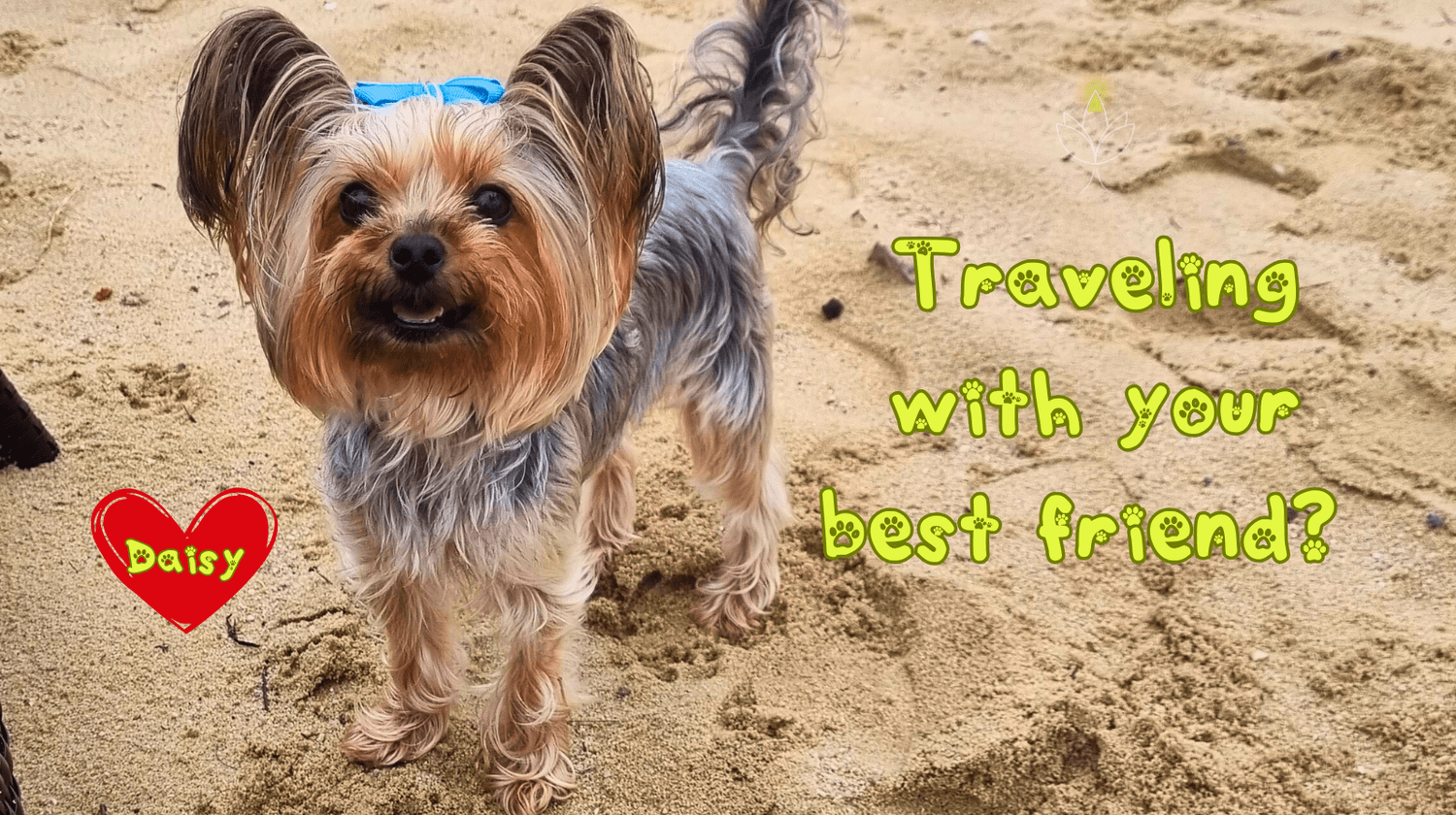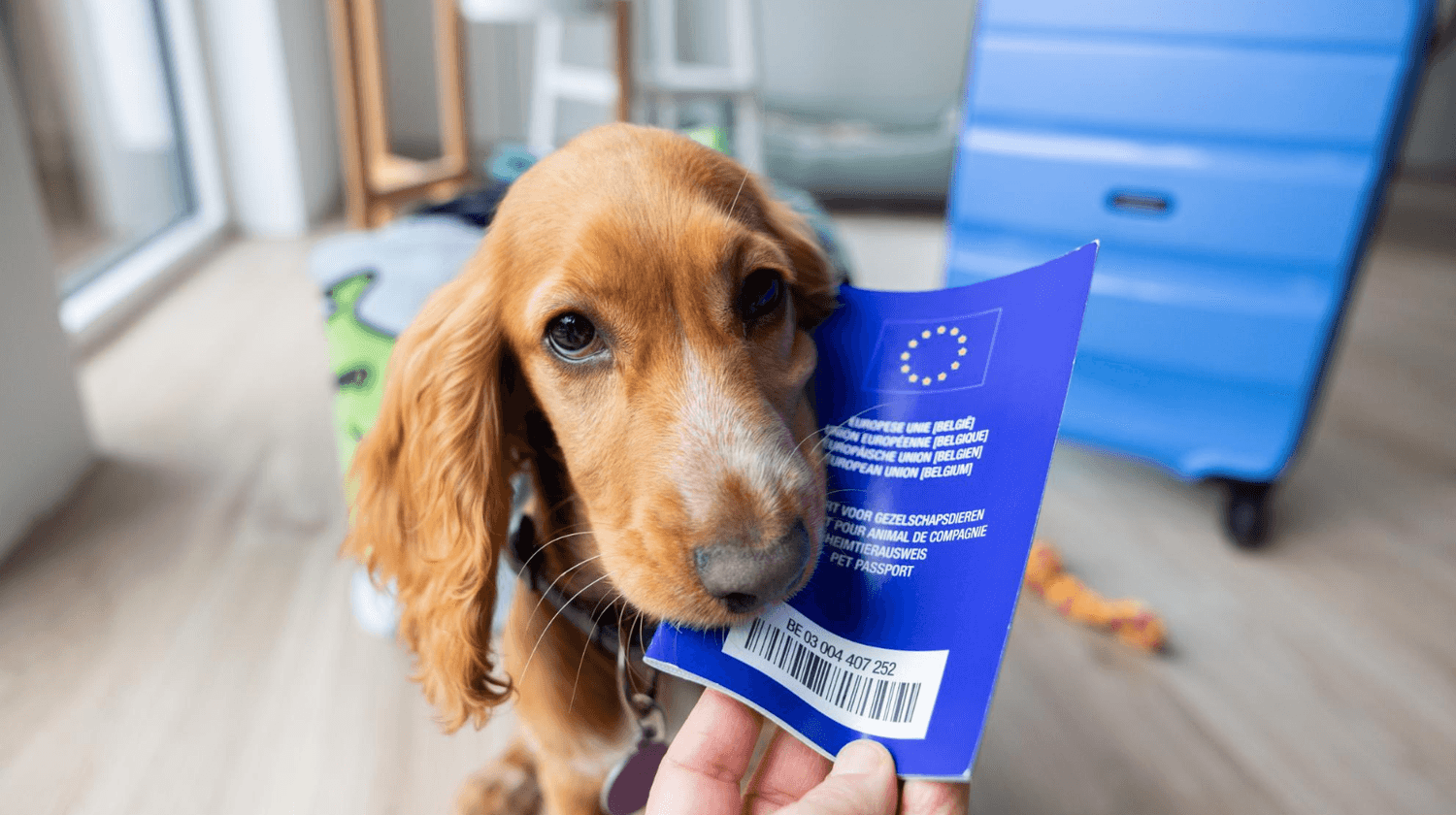How to Fly With Your Dog in the Cabin: My Experience Traveling the World With Daisy
This post may contain affiliate links. If you click and make a purchase, I may earn a small commission at no extra cost to you. Thank you for supporting Firefly so I can keep creating free travel content ✨
How to Fly With Your Dog in the Cabin - Complete Guide
We’ve traveled all over the world – from Europe to Central America, Asia, and the Middle East – always with our tiny Yorkshire Terrier, Daisy. She’s just 2 kg (yes, a little pocket-sized travel buddy 🐶✈️), and she’s been with us on every single flight. Always in the cabin, never in cargo.
Why? Because I would never, ever put my dog in the cargo hold - if the dog fits in the cabin. Too many horror stories float around online about what happens there, and for me, it’s simply not worth the risk. That’s why I often paid for more expensive tickets, chose longer routes, and even changed airlines – just to make sure Daisy could stay with me in the cabin.
If you’re planning to fly with your dog, I want to share everything I’ve learned: the steps you should take before booking a flight, the documents you’ll need, airline rules you must check, and what to expect when you land. This is your complete guide to traveling with a dog on a plane – stress-free and safe.

👉 Note: “These photos aren’t staged in fancy studios or pet hotels – they’re real snapshots from our travels with Daisy. Honestly, I never thought these would end up in a blog, but I guess the real moments tell the best story.”
Here’s the exact carrier we’ve used for flying with Daisy in cabin – it’s lightweight, airline-approved and we’ve never had any issues with it. 🐾✨
👉 Link to the carrier
Step 1: Check Which Airlines Allow Dogs in the Cabin
Not all airlines are pet-friendly. Some allow dogs in the cabin, some only in cargo, and others don’t accept pets at all.
👉 Always check airline policies before booking your ticket. You’ll find the rules on their official website.
From my experience:
Lufthansa – excellent choice, allows dogs in the cabin, no strict hour limit.
Air Canada – dog-friendly, cabin travel allowed.
Emirates – allows pets (with some paperwork).
Ethiopian Airlines – also pet-friendly.
Turkish Airlines – strict limit of 8 hours per flight, which can be tricky for long-haul routes.
Edelweiss Air – very pet-friendly, allows small dogs and cats in the cabin on most international flights.
Aeroméxico – accepts dogs in cabin if they meet weight and carrier requirements, a good option for flights to and from Latin America.
Air India – officially allows dogs in the cabin, but their process is very unusual and risky. Even if your dog meets all requirements and you buy your tickets, at check-in the pilot personally decides whether your dog is allowed on board. Imagine arriving at the airport with all documents in order, only for the pilot to say “no.” For us, this was simply too big of a risk. We didn’t want to gamble with Daisy being denied at the last moment. On top of that, Air India doesn’t have the best reputation, so instead we chose Ethiopian Airlines. It took a bit longer, but it was still the safer and more reliable choice.

⚡ Tip: Do not rely only on what a call center agent tells you – sometimes, even they get flight duration and pet rules wrong. Always double-check the official website - or ask twice!
Preview:
👉 This simple checklist has already saved me hours of stress and hundreds in unexpected costs – and now it’s yours, free.

Flying with your dog? Don’t risk being denied at the airport – grab this FREE 7-page checklist & notebook 🐾✈️

7 pages checklist and notebook
Step 2: Check Airline Requirements
Every airline has its own rules. The most common ones are:
Weight limit: usually around 8 kg (dog + carrier).
Carrier requirements: soft bag that fits under the seat. I used a small black carrier that looked like a handbag.
Age limit: most airlines don’t allow puppies under 8 weeks old.
Flight duration: some airlines limit pets in cabin on flights longer than a certain number of hours.

Step 3: Call the Airline Before Booking
This is one of the most important steps!
Airlines only allow a limited number of pets per flight (often just 2–4 in total).
Always call customer service before booking to check if there’s still space for your dog.
Some airlines let you add a pet in their app (like you’d add a meal or sports equipment). Others require you to call and add the pet manually.

⚡ Firefly Tip: Always ask for written confirmation by email that your dog is registered on the flight. Without it, you risk being denied boarding at the airport.
Step 4: Prepare the Required Documents
Every country has different rules, but here’s what you’ll usually need:
Rabies vaccination certificate.
Proof of other vaccinations against common canine diseases.
Health certificate from your vet stating your dog is fit to fly (some airlines request this).
Import forms required by the destination country – you can usually download these from government or veterinary authority websites.
Official stamps and vet signatures on all documents.
🌍 Example: When we flew into Costa Rica, everything was straightforward. In Nicaragua, it was trickier – we had to get Costa Rican papers re-approved by local vets. And in Dubai, things were the most complicated (more on that below).
Step 5: Boarding and Flying With Your Dog
At the airport:
Show all documents at check-in – the airline staff will verify everything.
Keep your dog in the carrier during boarding and flight (though I often let Daisy nap in my lap, covered with a blanket).
Bring water and a pee pad just in case.
Personal note: Daisy was amazing. She held it in for even 20+ hours on one of our longest journeys. She was calm, clean, and slept most of the way. 💤
Step 6: What to Expect After Landing
Every country has different arrival procedures:
Most airports: You visit the veterinary office at the airport, show documents, they check your dog, and you’re free to go.
Dubai exception: In Dubai, things are strict. The vet service will take your dog immediately after landing and transfer them to another facility outside the airport. You must take a taxi there to pick up your dog later. If you don’t have an Emirates ID, the process can be stressful and slow. This was the only time I felt panicked because Daisy was taken away from me without clear instructions.
So: Always research not just the departure rules, but also the arrival rules of your destination

Antibody Titer Test – Not Always Required, But Highly Recommended
When flying internationally with your dog, most airlines and countries only ask for standard vaccinations (like rabies) and health certificates. However, there’s one extra step that I strongly recommend: the antibody titer test.
✈️ Is it mandatory? In most cases, no. But some countries require it when entering or re-entering (for example, if you’ve been traveling through multiple destinations).
💉 Why is it useful? Because you never know where your travels might take you – and sometimes border authorities want extra proof that your dog’s rabies vaccine is effective. Having the titer test done in advance can save you from big headaches.
⏳ How long does it take? The test is not instant. It usually takes a few weeks to process results, so plan ahead and do it well before your flight.
💰 How much does it cost? Prices vary worldwide – typically between €50 and €150 depending on your country and vet.
👉 While it’s not a strict requirement for most flights, I personally see it as a smart safety net. It doesn’t harm your dog, but it could make your life a lot easier if a border official suddenly asks for it.

Watch out for connecting flights ✈️🐶
One of the trickiest parts of flying with your pup isn’t just the first flight – it’s what happens when you connect to another one. Even if you’ve bought your ticket as one booking, that doesn’t always mean your dog is automatically accepted on all the airlines involved.
Here’s the deal:
If your journey involves two different airlines, you need to contact both in advance.
Each airline has its own pet policy (cabin size, weight limits, fees, number of pets per flight).
You usually have to pay separately for your dog on each airline.
Some airlines simply don’t allow pets in cabin at all — even on a through-ticket.
👉 I’ve seen people stranded because the first airline said “yes” but the connecting one said “no.” Don’t let that be you!
Pro tip: Always call every single airline on your route, double-check their policies, and get written confirmation for each flight segment.
My Personal Experience
Daisy has flown in economy and in business class. She slept quietly, didn’t disturb anyone, and truly enjoyed traveling. With preparation, the right documents, and the right airline, flying with your dog in the cabin can be smooth and even enjoyable.
For me, the peace of mind of having her beside me was priceless.

Flying With a Dog – Checklist
✅ Check which airlines allow dogs in the cabin.
✅ Read the airline’s pet policy (weight, carrier, flight duration).
✅ Call the airline before booking and confirm there’s space for your dog.
✅ Get written confirmation that your dog is registered on the flight.
✅ Prepare documents: vaccinations, health certificate, import forms.
✅ Bring water, pee pads, and a soft carrier.
✅ Research arrival rules at your destination.

Food, Water & Pre-Flight Prep 🐾✈️
Here’s one thing most guides won’t tell you – what (not) to do before you even get to the airport. From my own experience (and yes, from my years of background in K9 training 🐕🦺), this part can make or break the whole journey.
Skip the food 12 hours before the flight
Trust me on this one – a short fast won’t harm your pup. But stress + full tummy = potential disaster. Dogs can get nauseous, stressed poops, or even diarrhea. And being stuck in a carrier when your belly hurts? Nope, not fun.Easy on the water
Keep them hydrated, but don’t let them gulp down a full bowl right before take-off. A few sips are perfect – enough so they’re comfy, not bursting for a pee break mid-air.Hydration matters
Little sips go a long way. You want them hydrated, just not uncomfortable.Walk it out before the airport
Long walk = magic. It helps them burn off extra energy, relax, and, let’s be real – take care of business before the flight. A calm, tired pup is the best travel buddy.
I’ve flown across the world with Daisy and this simple routine made every flight smoother. Think of it as setting your dog up for success before the adventure even begins. 🌍✨

FAQ: Flying With Dogs
Usually between $50–$200 per flight, depending on the airline.
Officially, airlines require dogs to stay in the carrier. But small dogs often nap in their owner’s lap – if they’re calm and discreet, crew usually doesn’t mind.
Yes – but rules depend on the airline and the country of arrival. Always check both.
From my experience: Lufthansa, Air Canada, Emirates, and Ethiopian Airlines were excellent. Turkish Airlines is strict on flight duration.
Personally, I don’t recommend it. Too many risks. That’s why I always chose airlines that allowed Daisy in the cabin.

✨ If you’re planning to fly with your furry friend, preparation is everything. With the right airline, proper paperwork, and a calm mindset, flying with your dog in the cabin is not only possible but it can also be enjoyable.
Daisy has been with us across the world, and I wouldn’t change a thing. 💛🐾
Share this article with someone who’s flying with their pup!
Hi, I'm Alenka

Welcome to my little corner of the internet — a cozy Firefly space where creativity meets freedom.
I share my love for online business, travel, and design — along with simple ways to turn your ideas into income and your dreams into everyday life.
Here, you’ll find practical tips, tools, and inspiration to help you build a business that fits you — so you can shine online and live life on your own terms.
✨ Loved this post?
Keep exploring — I’ve gathered a few more Firefly stories and guides that can spark new ideas and help you create, travel, and shine online. 🌍
→ Discover more articles below and keep the Firefly glow going. 💛
→ Check out my Canva mini course for beginners
My book Chakra Code helps you find balance, clarity, and flow — so abundance can find you too.
Some of the links in this blog are affiliate links. This means that if you decide to book or buy through them, I may receive a small commission. It won’t cost you anything extra – but it helps me keep Firefly alive and full of free travel tips ✨ Thank you for supporting my journey and helping me share the magic of travel with you 💜
✨ Join hundreds of creators and digital explorers already growing with Firefly!
Unlock exclusive access to free resources, step-by-step guides, and insider tips for creating digital products, growing your business, and living a more flexible lifestyle.
Don’t wait for the perfect moment – create it. Your dream life starts today.
Want a website like mine? Contact me!
© 2025 By-Firefly | Privacy Policy | Terms & Conditions | Pricing Plans | FAQ All Rights Reserved












